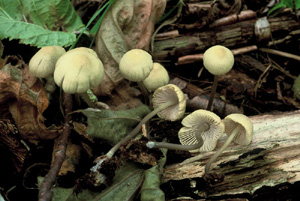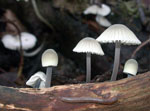Solitary, gregarious or fasciculate on decayed wood of fallen trees or branches,
on moss-covered trunks of deciduous trees, very rarely on
wood of conifers. Late summer to late autumn. Rare in Norway, and listed as NT
in The Norwegian Red List.
Pileus 10-25 mm across, almost cylindrical when very young, then conical to parabolical, flattening with age, becoming almost plane, with or without umbo, sulcate, translucent-striate, hygrophanous, appearing in two colour forms: either a pale, yellowish form with the centre more or less darker and with an olivaceous to sepia brown shade, finally turning pale grey to pale grey-brown, or a darker form which is watery sepia brown to fairly dark grey-brown, darker at the centre and often with some olivaceous shade, paler at the margin which often shows a yellowish shade. Odour indistinctive but of iodoform on drying out. Lamellae 16-30 reaching the stipe, ascending, dorsally intervenose with age, narrowly adnate, pale citrine to pale sulphur or pale grey-beige to whitish, often with a pinkish tinge. |

© Jukka Vauras |
Stipe 25-100 x 1-3 mm, hollow, equal, terete, straight to curved, smooth to very finely rugulose-fibrillose, entirely pruinose, glabrescent for the greater part except at the apex, at first pale violaceous grey, turning pale grey to pale grey-brown, with the apex whitish and the base long retaining violaceous shades (pale forms); or at first bluish grey, fairly pale bluish violet to steel blue, with age turning grey to sepia brown (dark form); the base covered with long, coarse, flexuous, whitish to yellowish fibrils.
Basidia 25-35 x 6.5-9 µm, clavate, 4-spored, with sterigmata 3.5-5 µm long. Spores (7-)8-9 x 4.5-5 µm, Q = 1.5-1.9, Qav ≈ 1.7, pip-shaped, smooth, amyloid. Cheilocystidia 17-65 x 7-24 µm, forming a sterile band, clavate to obpyriform, more rarely almost globose or somewhat irregularly shaped, covered with few to numerous warts or generally short, cylindrical excrescences. Pleurocystidia similar. Lamellar trama dextrinoid, vinaceous in Melzer's reagent. Hyphae of the pileipellis 1-7 µm wide, covered with few to numerous warts or cylindrical excrescences up to 22 µm long, becoming very much branched and tending to become gelatinized. Hyphae of the cortical layer of the stipe 3-8 µm wide, covered with scattered, short cylindrical excrescences1-4 x 0.5-1 µm, terminal cells up to 10 µm wide, clavate, diverticulate. Clamp connections present at all tissues.
Microphotos of cheilocystidia
Microphotos of pileipellis and stipitipellis
Mycena arcangeliana is a member of sect. Filipedes (Fr.) Quél., where it can be separated from the other members on account of the yellowish to olivaceous shades present at the pileus and the bluish to violaceous shades present at the stipe. The pink colour often present at the lamellae is also a distinctive feature. In M. peyerimhoffi Maire, a poorly known species described from Algeria, the pileus is yellow but the stipe is yellow too (Maas Geesteranus 1984: 439). M. limonia Maas Geest. is another yellow species, described from The Netherlands. It differs from M. arcangeliana by the lemon yellow pileus and stipe, a larger number of lamellae, and smooth hyphae of the pileipellis with conspicuous terminal cells. M. arcangeliana can also be misidentified as Mycena chlorantha (Fr.) P. Kumm. Observations and collections of Mycena chlorantha from woods have often proved to be misidentifications of Mycena arcangeliana. M. chlorantha, however, grows exclusively on grasses, especially on Ammophila in coastal sand dunes and coastal grassland (Elborne 1996).
 Next image Next image
Further images on the Internet:
|